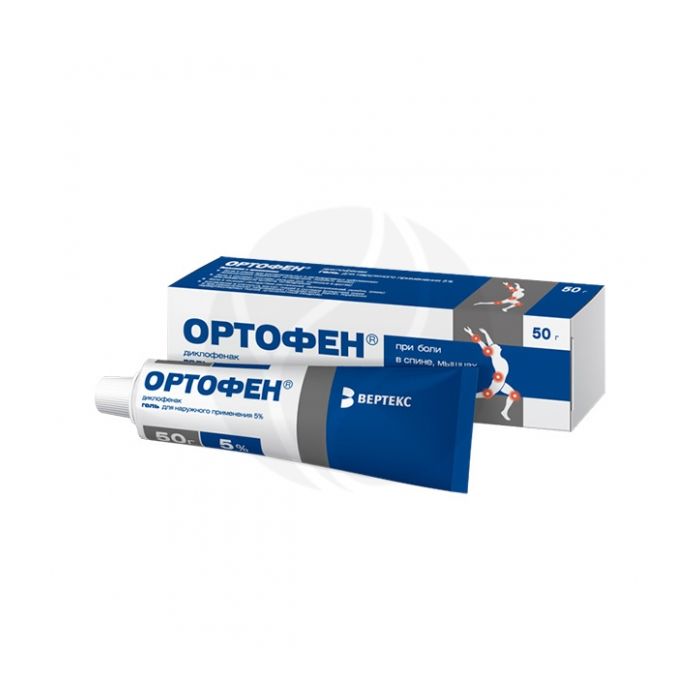Ortofen gel 5%, 50 g
Expiration Date: 05/2027
Russian Pharmacy name:
Ортофен гель 5%, 50 г
Back pain in inflammatory and degenerative diseases of the spine (sciatica, osteoarthritis, lumbago, sciatica);
joint pain (including finger joints, knee joints) in case of rheumatoid arthritis, osteoarthritis;
muscle pain (due to sprains, overexertion, bruises, injuries);
inflammation and swelling of soft tissues and joints due to injuries and rheumatic diseases (tendovaginitis, bursitis, lesions of periarticular tissues).
For adults and children over the age of 12 years, the drug should be applied to the skin over the area of ??inflammation 3-4 times / day, for children aged 6 to 12 years - up to 2 times / day.
The duration of use depends on the indications and the effectiveness of the treatment. After 2 weeks of using the drug, the patient should consult a doctor.
Gel for external use, colorless or with a yellowish tinge, transparent, with a characteristic smell of ethanol; opalescence and air bubbles are allowed.
100 g diclofenac sodium 5 g
Excipients: propylene glycol 5 g, ethanol 95% 30 g, hyetellose 2.5 g, purified water up to 100 g.
'Aspirin triad' (attacks of bronchial asthma, urticaria and acute rhinitis while taking acetylsalicylic acid or other NSAIDs);
violation of the integrity of the skin at the site of application of the drug;
III trimester of pregnancy; lactation period (breastfeeding);
children under 6 years of age and older, depending on the drug used;
hypersensitivity to diclofenac, other NSAIDs or to any of the excipients of the drug used.
With care: hepatic porphyria (in the acute phase); erosive and ulcerative lesions of the gastrointestinal tract; severe impairment of liver and kidney function; chronic heart failure; bronchial asthma; violation of blood clotting (including hemophilia, lengthening of bleeding time, tendency to bleeding); I and II trimesters of pregnancy; elderly patients.
pharmachologic effect
NSAIDs for external use, a derivative of phenylacetic acid. It has anti-inflammatory and analgesic effects. The mechanism of action is due to the inhibition of the activity of COX-1 and COX-2, which leads to disruption of the metabolism of arachidonic acid and the synthesis of prostaglandins, which are the main link in the development of inflammation.
When applied externally, it leads to the disappearance or weakening of pain at the site of application, reduces pain in joints at rest and during movement, as well as morning stiffness and swelling of the joints. Promotes an increase in the range of motion in the affected joints.
Pharmacokinetics
The amount of diclofenac absorbed through the skin is proportional to the area of ??the treated surface and depends both on the total dose of the applied drug and on the degree of skin hydration. The binding of diclofenac to plasma proteins is 99.7%, mainly to albumin (99.4%). Diclofenac is predominantly distributed and retained deep in tissues prone to inflammation, such as joints, where its concentration is 20 times higher than in plasma.
Diclofenac metabolism is carried out in part by glucuronidation of the unchanged molecule, but mainly through single and repeated hydroxylation, which leads to the formation of several phenolic metabolites, most of which are converted to glucuronide conjugates. Two phenolic metabolites are biologically active, but to a significantly lesser extent than diclofenac.
The total systemic plasma clearance of diclofenac is 263 ± 56 ml / min.
The final T1 / 2 is 1-2 hours. T1 / 2 of metabolites, including two pharmacologically active ones, is also short and is 1-3 hours. One of the metabolites (3'-hydroxy-4'-methoxydiclofenac) has a longer T1 / 2, however, this metabolite is completely inactive. Most of diclofenac and its metabolites are excreted in the urine.
Side effect
Infectious and parasitic diseases: very rarely - pustular eruptions.
From the immune system: very rarely - generalized skin rash, allergic reactions (urticaria, hypersensitivity: angioedema).
On the part of the respiratory system and organs of the chest and mediastinum: very rarely - attacks of suffocation, bronchospastic reactions.
From the side of the skin: often - erythema, dermatitis, incl. contact dermatitis (symptoms: eczema, itching, swelling of the treated skin area, rash, papules, vesicles, peeling); rarely, bullous dermatitis; very rarely - photosensitivity reactions.
Application during pregnancy and lactation
Use in the third trimester of pregnancy is contraindicated due to the possibility of a decrease in the tone of the uterus and / or premature closure of the arterial duct of the fetus.
Application in the I and II trimesters of pregnancy is possible in cases where the potential benefit to the mother outweighs the potential risk to the fetus or infant.
Use during lactation (breastfeeding) is contraindicated.
Application for violations of liver function
Use with extreme caution in case of liver disease in history.
Application for impaired renal function
Use with extreme caution in case of a history of kidney disease.
Application in children
Not recommended for use in children under 6 years of age.
Use in elderly patients
Use with extreme caution in elderly patients.
special instructions
Apply only to intact skin.
Avoid getting the drug in the eyes, mucous membranes or open wounds.
Do not use under airtight (occlusive) dressings.
Care must be taken when applying large amounts of the drug to large surfaces of sensitive skin over an extended period of time. When used with other dosage forms of diclofenac, the total maximum daily dose should be taken into account.
During the application period, prolonged exposure to the sun should be avoided.
Drug interactions
Drugs that cause photosensitization - an increase in the action of drugs that can cause photosensitization.

